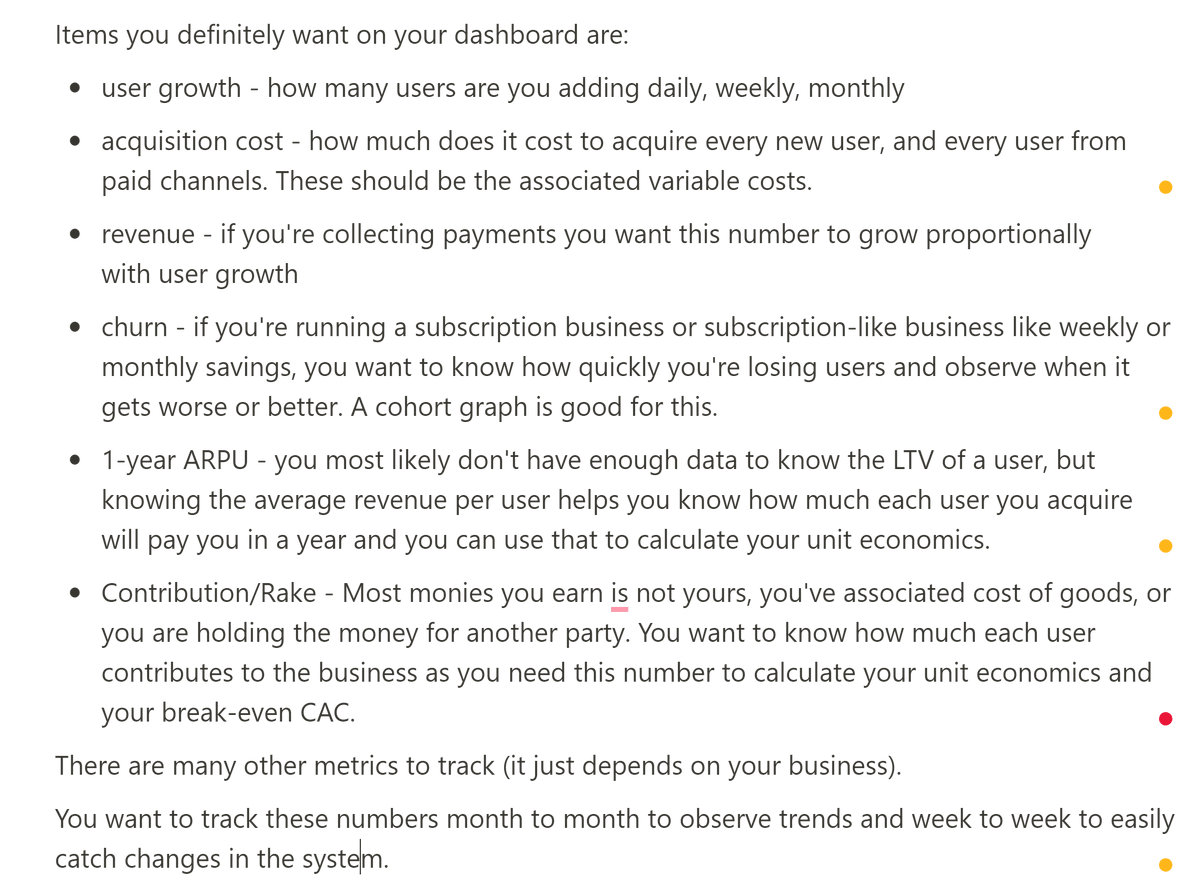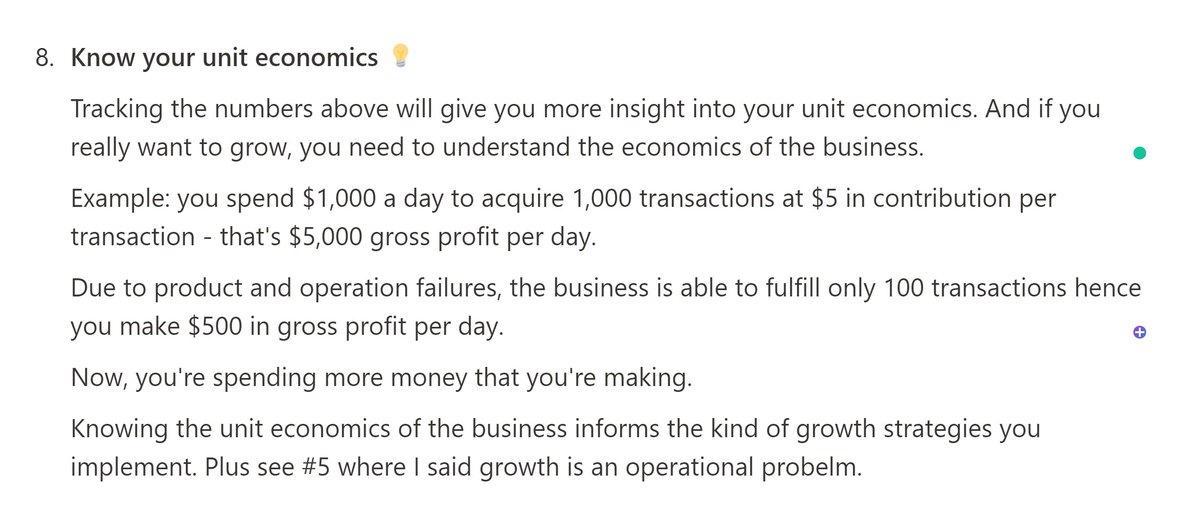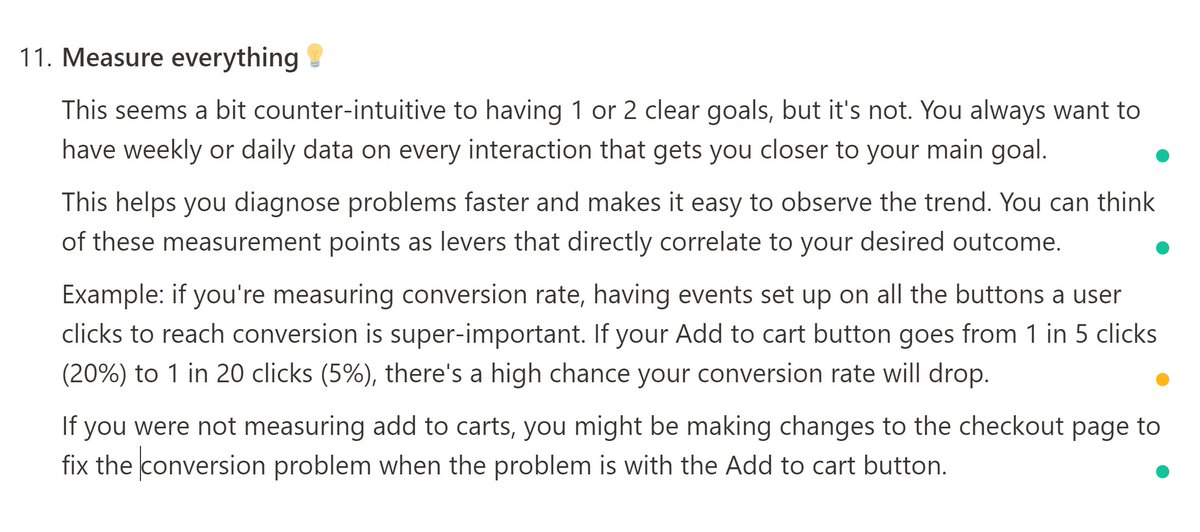You& #39;ve just been hired to lead growth at a startup?
Here are 14 things you need to know to drive growth https://abs.twimg.com/emoji/v2/... draggable="false" alt="🚀" title="Rakete" aria-label="Emoji: Rakete">
https://abs.twimg.com/emoji/v2/... draggable="false" alt="🚀" title="Rakete" aria-label="Emoji: Rakete">
 https://abs.twimg.com/emoji/v2/... draggable="false" alt="🧵" title="Thread" aria-label="Emoji: Thread"> by @yemi_uc
https://abs.twimg.com/emoji/v2/... draggable="false" alt="🧵" title="Thread" aria-label="Emoji: Thread"> by @yemi_uc
Here are 14 things you need to know to drive growth
1. Recognize that you& #39;re somewhat responsible for the business in your role  https://abs.twimg.com/emoji/v2/... draggable="false" alt="💡" title="Elektrische Glühbirne" aria-label="Emoji: Elektrische Glühbirne">
https://abs.twimg.com/emoji/v2/... draggable="false" alt="💡" title="Elektrische Glühbirne" aria-label="Emoji: Elektrische Glühbirne">
In some companies, product is responsible for driving business growth, in some others it& #39;s finance, in some others it& #39;s sales, and in many startups, it& #39;s the growth team.
In some companies, product is responsible for driving business growth, in some others it& #39;s finance, in some others it& #39;s sales, and in many startups, it& #39;s the growth team.
Were you hired because no one knows how to do marketing on the team or were you hired because the company believes your role is important to business growth?
2. There are many problems to solve. Don& #39;t try and get into everything  https://abs.twimg.com/emoji/v2/... draggable="false" alt="💡" title="Elektrische Glühbirne" aria-label="Emoji: Elektrische Glühbirne">
https://abs.twimg.com/emoji/v2/... draggable="false" alt="💡" title="Elektrische Glühbirne" aria-label="Emoji: Elektrische Glühbirne">
If you were not hired as an internal contributor, but as a manager don& #39;t get into execution in Month 1. Zoom out and understand the business& #39; growth problems because they are more nuanced than you think.
If you were not hired as an internal contributor, but as a manager don& #39;t get into execution in Month 1. Zoom out and understand the business& #39; growth problems because they are more nuanced than you think.
Use a high-level framework like AARRR growth framework to figure out how the business is performing in each stage. If you don& #39;t apply a high-level framework, you will have an incoherent growth plan.
Example: solving for monetization and traffic at the same time is distracting for your product thinking, and you& #39;ll both be under-investing in the 2 of them because they require different types of product thinking.
3. Another great framework is "Revenue = Traffic * conversion rate * LTV/AOV"  https://abs.twimg.com/emoji/v2/... draggable="false" alt="💡" title="Elektrische Glühbirne" aria-label="Emoji: Elektrische Glühbirne">
https://abs.twimg.com/emoji/v2/... draggable="false" alt="💡" title="Elektrische Glühbirne" aria-label="Emoji: Elektrische Glühbirne">
If you work in eCom and marketplaces, then treat this framework as your bible.
You can solve your traffic problems independently of your monetization problems with very clear thinking.
If you work in eCom and marketplaces, then treat this framework as your bible.
You can solve your traffic problems independently of your monetization problems with very clear thinking.
4. Don& #39;t jump into retention unless it is really bad  https://abs.twimg.com/emoji/v2/... draggable="false" alt="💡" title="Elektrische Glühbirne" aria-label="Emoji: Elektrische Glühbirne">
https://abs.twimg.com/emoji/v2/... draggable="false" alt="💡" title="Elektrische Glühbirne" aria-label="Emoji: Elektrische Glühbirne">
It& #39;s incredibly hard to fix retention and if you don& #39;t have 1000s of users performing your retention metric - DAU, WAU, MAU, et al - then you won& #39;t have enough data to fix anything and you would have burnt time.
It& #39;s incredibly hard to fix retention and if you don& #39;t have 1000s of users performing your retention metric - DAU, WAU, MAU, et al - then you won& #39;t have enough data to fix anything and you would have burnt time.
Retention is important, but figuring out acquisition is more important in many instances.
Example: eCommerce companies sometimes have to re-acquire the same user multiple times via paid marketing, and that& #39;s fine because they turn a profit on each transaction.
Example: eCommerce companies sometimes have to re-acquire the same user multiple times via paid marketing, and that& #39;s fine because they turn a profit on each transaction.
5. Fixing growth is an operational problem that cuts across multiple teams (engineering, product, finance, marketing, customer support, operations)  https://abs.twimg.com/emoji/v2/... draggable="false" alt="💡" title="Elektrische Glühbirne" aria-label="Emoji: Elektrische Glühbirne">
https://abs.twimg.com/emoji/v2/... draggable="false" alt="💡" title="Elektrische Glühbirne" aria-label="Emoji: Elektrische Glühbirne">
Often, your influence will stop at marketing and maybe you will be given engineering resources sometimes.
Often, your influence will stop at marketing and maybe you will be given engineering resources sometimes.
Use engineering to make your marketing better instead of trying to build one-off ideas or products that will need updates.
Example: Engineering can help you solve your paid marketing attribution problem, or help you do programmatic SEO, or help build out an affiliate program.
Example: Engineering can help you solve your paid marketing attribution problem, or help you do programmatic SEO, or help build out an affiliate program.
The point is, don& #39;t use engineering to build new products. Use engineering to enhance your marketing capabilities.
6. Select a growth stage to give attention  https://abs.twimg.com/emoji/v2/... draggable="false" alt="💡" title="Elektrische Glühbirne" aria-label="Emoji: Elektrische Glühbirne">
https://abs.twimg.com/emoji/v2/... draggable="false" alt="💡" title="Elektrische Glühbirne" aria-label="Emoji: Elektrische Glühbirne">
Often this will be acquisition, but each company is different and you need to know what is important to the business when you& #39;re joining (posting user growth, solving retention, revenue expansion, et al).
Often this will be acquisition, but each company is different and you need to know what is important to the business when you& #39;re joining (posting user growth, solving retention, revenue expansion, et al).
7. Spend your 1st and 2nd month understanding the business and building out your growth dashboard  https://abs.twimg.com/emoji/v2/... draggable="false" alt="💡" title="Elektrische Glühbirne" aria-label="Emoji: Elektrische Glühbirne">
https://abs.twimg.com/emoji/v2/... draggable="false" alt="💡" title="Elektrische Glühbirne" aria-label="Emoji: Elektrische Glühbirne">
You& #39;ll definitely revisit this almost every month until your 6th or even 12th month when you understand all the nuance of the business.
Tap the screenshot to see must-haves
You& #39;ll definitely revisit this almost every month until your 6th or even 12th month when you understand all the nuance of the business.
Tap the screenshot to see must-haves
You can use a spreadsheet to track these numbers. You don& #39;t need any fancy tools.
You want to track these numbers month to month to observe trends and week to week to easily catch changes in the system.
You want to track these numbers month to month to observe trends and week to week to easily catch changes in the system.
8. Know your unit economics  https://abs.twimg.com/emoji/v2/... draggable="false" alt="💡" title="Elektrische Glühbirne" aria-label="Emoji: Elektrische Glühbirne">
https://abs.twimg.com/emoji/v2/... draggable="false" alt="💡" title="Elektrische Glühbirne" aria-label="Emoji: Elektrische Glühbirne">
Your growth strategy needs to be repeatable and scalable. Knowing your unit economics lets you know the idea space you can operate.
Your growth strategy needs to be repeatable and scalable. Knowing your unit economics lets you know the idea space you can operate.
9. Deploy strategies not tactics  https://abs.twimg.com/emoji/v2/... draggable="false" alt="💡" title="Elektrische Glühbirne" aria-label="Emoji: Elektrische Glühbirne">
https://abs.twimg.com/emoji/v2/... draggable="false" alt="💡" title="Elektrische Glühbirne" aria-label="Emoji: Elektrische Glühbirne">
Growth is about finding a repeatable, insight-driven process to fix your business problems. You cannot get that with tactics.
With a solid strategy, you put in x and you get y. Your growth should be as mechanical as that.
Growth is about finding a repeatable, insight-driven process to fix your business problems. You cannot get that with tactics.
With a solid strategy, you put in x and you get y. Your growth should be as mechanical as that.
10. Your strategies for each stage should have not more than 2 goals (make it 1 if possible)  https://abs.twimg.com/emoji/v2/... draggable="false" alt="💡" title="Elektrische Glühbirne" aria-label="Emoji: Elektrische Glühbirne">
https://abs.twimg.com/emoji/v2/... draggable="false" alt="💡" title="Elektrische Glühbirne" aria-label="Emoji: Elektrische Glühbirne">
Example: solving blog traffic requires a different kind of thinking than solving for email capture.
Example: solving blog traffic requires a different kind of thinking than solving for email capture.
11. Measure everything  https://abs.twimg.com/emoji/v2/... draggable="false" alt="💡" title="Elektrische Glühbirne" aria-label="Emoji: Elektrische Glühbirne">
https://abs.twimg.com/emoji/v2/... draggable="false" alt="💡" title="Elektrische Glühbirne" aria-label="Emoji: Elektrische Glühbirne">
This seems a bit counter-intuitive to having 1 or 2 clear goals, but it& #39;s not.
You always want to have weekly or daily data on every interaction that gets you closer to your core metrics.
This seems a bit counter-intuitive to having 1 or 2 clear goals, but it& #39;s not.
You always want to have weekly or daily data on every interaction that gets you closer to your core metrics.
12. Growth should be mechanical and predictable https://abs.twimg.com/emoji/v2/... draggable="false" alt="💡" title="Elektrische Glühbirne" aria-label="Emoji: Elektrische Glühbirne">
https://abs.twimg.com/emoji/v2/... draggable="false" alt="💡" title="Elektrische Glühbirne" aria-label="Emoji: Elektrische Glühbirne">
Often, "growth teams" are looking for their next dope tweet or their next viral blog instead of creating a factory that understands how to create dope tweets or creating a content factory that self-distributes content.
Often, "growth teams" are looking for their next dope tweet or their next viral blog instead of creating a factory that understands how to create dope tweets or creating a content factory that self-distributes content.
13. Try to tie your growth strategies to money in the bank  https://abs.twimg.com/emoji/v2/... draggable="false" alt="💡" title="Elektrische Glühbirne" aria-label="Emoji: Elektrische Glühbirne">
https://abs.twimg.com/emoji/v2/... draggable="false" alt="💡" title="Elektrische Glühbirne" aria-label="Emoji: Elektrische Glühbirne">
The business needs to make money, so you need to be clear on how your work affects the company& #39;s bank balance.
The business needs to make money, so you need to be clear on how your work affects the company& #39;s bank balance.
14. Repeat all the steps above as frequently as you can  https://abs.twimg.com/emoji/v2/... draggable="false" alt="💡" title="Elektrische Glühbirne" aria-label="Emoji: Elektrische Glühbirne">
https://abs.twimg.com/emoji/v2/... draggable="false" alt="💡" title="Elektrische Glühbirne" aria-label="Emoji: Elektrische Glühbirne">
There& #39;s always new information and what you believe before about the business changes, so review your growth plans every month or quarter to be sure you& #39;re not moving in the wrong direction.
There& #39;s always new information and what you believe before about the business changes, so review your growth plans every month or quarter to be sure you& #39;re not moving in the wrong direction.
Lastly, each business is different, so you need to solve for your specific problems. You can& #39;t apply the lessons here verbatim.
If you like this thread, subscribe to https://africanstartupteardownpod.substack.com/p/coming-soon ">https://africanstartupteardownpod.substack.com/p/coming-...
Subscribers get first access to every podcast where @yemi_uc and @NnamdiO_ teardown how consumer internet companies in Africa grow.
And if you don& #39;t like the thread, you& #39;re a witch https://abs.twimg.com/emoji/v2/... draggable="false" alt="😂" title="Gesicht mit Freudentränen" aria-label="Emoji: Gesicht mit Freudentränen">
https://abs.twimg.com/emoji/v2/... draggable="false" alt="😂" title="Gesicht mit Freudentränen" aria-label="Emoji: Gesicht mit Freudentränen">
Subscribers get first access to every podcast where @yemi_uc and @NnamdiO_ teardown how consumer internet companies in Africa grow.
And if you don& #39;t like the thread, you& #39;re a witch

 Read on Twitter
Read on Twitter You& #39;ll definitely revisit this almost every month until your 6th or even 12th month when you understand all the nuance of the business.Tap the screenshot to see must-haves" title="7. Spend your 1st and 2nd month understanding the business and building out your growth dashboard https://abs.twimg.com/emoji/v2/... draggable="false" alt="💡" title="Elektrische Glühbirne" aria-label="Emoji: Elektrische Glühbirne">You& #39;ll definitely revisit this almost every month until your 6th or even 12th month when you understand all the nuance of the business.Tap the screenshot to see must-haves" class="img-responsive" style="max-width:100%;"/>
You& #39;ll definitely revisit this almost every month until your 6th or even 12th month when you understand all the nuance of the business.Tap the screenshot to see must-haves" title="7. Spend your 1st and 2nd month understanding the business and building out your growth dashboard https://abs.twimg.com/emoji/v2/... draggable="false" alt="💡" title="Elektrische Glühbirne" aria-label="Emoji: Elektrische Glühbirne">You& #39;ll definitely revisit this almost every month until your 6th or even 12th month when you understand all the nuance of the business.Tap the screenshot to see must-haves" class="img-responsive" style="max-width:100%;"/>
 Your growth strategy needs to be repeatable and scalable. Knowing your unit economics lets you know the idea space you can operate." title="8. Know your unit economics https://abs.twimg.com/emoji/v2/... draggable="false" alt="💡" title="Elektrische Glühbirne" aria-label="Emoji: Elektrische Glühbirne">Your growth strategy needs to be repeatable and scalable. Knowing your unit economics lets you know the idea space you can operate." class="img-responsive" style="max-width:100%;"/>
Your growth strategy needs to be repeatable and scalable. Knowing your unit economics lets you know the idea space you can operate." title="8. Know your unit economics https://abs.twimg.com/emoji/v2/... draggable="false" alt="💡" title="Elektrische Glühbirne" aria-label="Emoji: Elektrische Glühbirne">Your growth strategy needs to be repeatable and scalable. Knowing your unit economics lets you know the idea space you can operate." class="img-responsive" style="max-width:100%;"/>
 Growth is about finding a repeatable, insight-driven process to fix your business problems. You cannot get that with tactics.With a solid strategy, you put in x and you get y. Your growth should be as mechanical as that." title="9. Deploy strategies not tactics https://abs.twimg.com/emoji/v2/... draggable="false" alt="💡" title="Elektrische Glühbirne" aria-label="Emoji: Elektrische Glühbirne"> Growth is about finding a repeatable, insight-driven process to fix your business problems. You cannot get that with tactics.With a solid strategy, you put in x and you get y. Your growth should be as mechanical as that." class="img-responsive" style="max-width:100%;"/>
Growth is about finding a repeatable, insight-driven process to fix your business problems. You cannot get that with tactics.With a solid strategy, you put in x and you get y. Your growth should be as mechanical as that." title="9. Deploy strategies not tactics https://abs.twimg.com/emoji/v2/... draggable="false" alt="💡" title="Elektrische Glühbirne" aria-label="Emoji: Elektrische Glühbirne"> Growth is about finding a repeatable, insight-driven process to fix your business problems. You cannot get that with tactics.With a solid strategy, you put in x and you get y. Your growth should be as mechanical as that." class="img-responsive" style="max-width:100%;"/>
 Example: solving blog traffic requires a different kind of thinking than solving for email capture." title="10. Your strategies for each stage should have not more than 2 goals (make it 1 if possible) https://abs.twimg.com/emoji/v2/... draggable="false" alt="💡" title="Elektrische Glühbirne" aria-label="Emoji: Elektrische Glühbirne">Example: solving blog traffic requires a different kind of thinking than solving for email capture." class="img-responsive" style="max-width:100%;"/>
Example: solving blog traffic requires a different kind of thinking than solving for email capture." title="10. Your strategies for each stage should have not more than 2 goals (make it 1 if possible) https://abs.twimg.com/emoji/v2/... draggable="false" alt="💡" title="Elektrische Glühbirne" aria-label="Emoji: Elektrische Glühbirne">Example: solving blog traffic requires a different kind of thinking than solving for email capture." class="img-responsive" style="max-width:100%;"/>
 This seems a bit counter-intuitive to having 1 or 2 clear goals, but it& #39;s not. You always want to have weekly or daily data on every interaction that gets you closer to your core metrics." title="11. Measure everything https://abs.twimg.com/emoji/v2/... draggable="false" alt="💡" title="Elektrische Glühbirne" aria-label="Emoji: Elektrische Glühbirne">This seems a bit counter-intuitive to having 1 or 2 clear goals, but it& #39;s not. You always want to have weekly or daily data on every interaction that gets you closer to your core metrics." class="img-responsive" style="max-width:100%;"/>
This seems a bit counter-intuitive to having 1 or 2 clear goals, but it& #39;s not. You always want to have weekly or daily data on every interaction that gets you closer to your core metrics." title="11. Measure everything https://abs.twimg.com/emoji/v2/... draggable="false" alt="💡" title="Elektrische Glühbirne" aria-label="Emoji: Elektrische Glühbirne">This seems a bit counter-intuitive to having 1 or 2 clear goals, but it& #39;s not. You always want to have weekly or daily data on every interaction that gets you closer to your core metrics." class="img-responsive" style="max-width:100%;"/>
 Often, "growth teams" are looking for their next dope tweet or their next viral blog instead of creating a factory that understands how to create dope tweets or creating a content factory that self-distributes content." title="12. Growth should be mechanical and predictablehttps://abs.twimg.com/emoji/v2/... draggable="false" alt="💡" title="Elektrische Glühbirne" aria-label="Emoji: Elektrische Glühbirne">Often, "growth teams" are looking for their next dope tweet or their next viral blog instead of creating a factory that understands how to create dope tweets or creating a content factory that self-distributes content." class="img-responsive" style="max-width:100%;"/>
Often, "growth teams" are looking for their next dope tweet or their next viral blog instead of creating a factory that understands how to create dope tweets or creating a content factory that self-distributes content." title="12. Growth should be mechanical and predictablehttps://abs.twimg.com/emoji/v2/... draggable="false" alt="💡" title="Elektrische Glühbirne" aria-label="Emoji: Elektrische Glühbirne">Often, "growth teams" are looking for their next dope tweet or their next viral blog instead of creating a factory that understands how to create dope tweets or creating a content factory that self-distributes content." class="img-responsive" style="max-width:100%;"/>
 The business needs to make money, so you need to be clear on how your work affects the company& #39;s bank balance." title="13. Try to tie your growth strategies to money in the bank https://abs.twimg.com/emoji/v2/... draggable="false" alt="💡" title="Elektrische Glühbirne" aria-label="Emoji: Elektrische Glühbirne">The business needs to make money, so you need to be clear on how your work affects the company& #39;s bank balance." class="img-responsive" style="max-width:100%;"/>
The business needs to make money, so you need to be clear on how your work affects the company& #39;s bank balance." title="13. Try to tie your growth strategies to money in the bank https://abs.twimg.com/emoji/v2/... draggable="false" alt="💡" title="Elektrische Glühbirne" aria-label="Emoji: Elektrische Glühbirne">The business needs to make money, so you need to be clear on how your work affects the company& #39;s bank balance." class="img-responsive" style="max-width:100%;"/>


